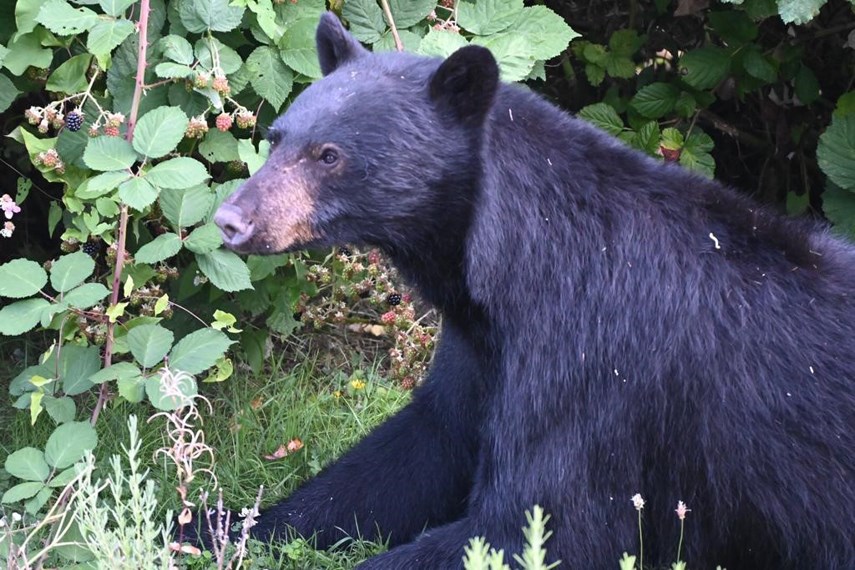A word can act like a paintbrush. Each brush stroke, line and curve brings into focus a final image. And the words used by government agencies and the media paint an inaccurate, distorted image of bears.
Imagine the silhouette of a bear painted directly onto a wall. The shape is dictated by the words, which fill the space. Words like "aggressive," "dangerous" and "offending" twist what would be a rounded shoulder into one spiked with hackles up. The snout, normally chomping on dandelions, instead roars from words like "problem" bear and "conflict" bear. Judgments on the bear’s behaviour or intents like "habituated," "encroaching" or "food conditioned" lead to more jagged edges. These terms misshape the outline, making words such as "euthanized" or "put down" intentionally take away the bitter sting of the more accurate or truthful word "killed," which is not included in this image. No one wants to take ownership of killing a bear.
None of these words were born of imagination. Each word has been pulled from media headlines and provincial government documents where agencies such as the B.C. Conservation Officer Service are granted the power to kill bears. The BCCOS is managed under the Ministry of Environment and Climate Change Strategy; however, all policy and guidelines are created by the Ministry of Forests, Lands, Natural Resource Operations and Rural Development. The latter ministry is responsible for capitalizing on the environment economically.
The language used in government documents must change. B.C.'s Wildlife Act refers to animals, including bears, as "dangerous wildlife" throughout. Conservation officers also issue dangerous wildlife protection orders. The word "dangerous" misrepresents the true nature of bears. Why not use the scientific classification? "Large carnivore" should replace "dangerous wildlife." The term DWPO should be shortened to a wildlife protection order. The government’s word choices create fear and lead to unreasonable responses, creating misunderstandings in the communities where bears live.
Other words used in government documents like "habituation" wrongly place the blame on bears. According to BCCOS conflict response guidelines, a "habituated" bear is defined as a bear increasingly coming into conflict with people. The bear’s behaviour is interpreted as an animal that is too comfortable around human presence. The language points the finger at the bear, not the public, regardless of whether someone has attracted them by leaving out unsecured garbage or approached wildlife to grab a selfie. If a bear is deemed "habituated," they are categorized as a threat to public safety and therefore can be killed. "Habituation" of a bear is also determined by the CO based on whether the animal flees from people or not. However, bears by nature are tolerant creatures. They don’t always run away in fear, and they don’t always object to human presence.
These guidelines generalize and vilify bears as the "offending" animal, implying the animal is committing an illegal act. The language is arguably tactical; if bears are painted as the villains of the story, people may be more willing to accept the killings of hundreds of bears. Other terms, such as referring to an animal as "it" further makes the killing of a bear more palatable. And soft words for kill, such as "euthanize" and "put down" are readily used in government documents, press releases and by officials when interviewed by media about so-called "conflict."
This itself is part of the problem: many of us look at humans and animals as being in "conflict." "Conflict" suggests that there are two parties that don’t agree. Wild animals are not willing participants, so it isn’t a "conflict;" it is simply an interaction.
The adoption of a universal language about human and bear interactions created by scientists, researchers and bear viewing guides who have experience with a broad spectrum of bears is needed to replace the words that make headlines. When government officials and media use words like dangerous, the public’s perception of everyday events can shift.
This perception leads to how people react to a bear sighting, and this plays a big role in how officials will respond. If the public believes bears are often "dangerous," they will describe a bear interaction through that lens and a "sighting" becomes a "stalking." The more heated the phone call, the more heated the response.
We believe the continued use of such language impedes efforts within communities to coexist with wildlife and are calling on government agencies to adapt their language to a 21st century standard, rooted in science.
Learn more at the Bear Alliance website.
Sylvia Dolson is the co-chair of the BC Bear Alliance and author of three books. Ellie Lamb is a bear viewing guide of 20 years and director of the North Shore Black Bear Society. Lesley Fox is the executive director of The Fur-Bearers, a charitable wildlife organization founded in 1953.
What are your thoughts? Send us a letter via email by clicking here or post a comment below



